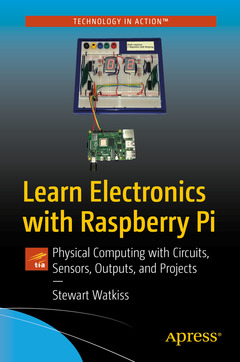Description
Learn Electronics with Raspberry Pi (2nd Ed., 2nd ed.)
Physical Computing with Circuits, Sensors, Outputs, and Projects
Author: Watkiss Stewart
Language: English
Keywords
Arduino; Minecraft; LEGO; electronics; programming; Redstone; maker
379 p. · 17.8x25.4 cm · Paperback
Description
/li>Contents
/li>Biography
/li>Comment
/li>
Raspberry Pi is everywhere, it?s inexpensive, and it's a wonderful tool for teaching about electronics and programming. This book demonstrates how to make a variety of cool projects using the Pi with programming languages like Scratch and Python, with no experience necessary. You'll see how the Pi works, how to work with Raspbian Linux on the Pi, and how to design and create electronic circuits.
You'll create projects like an arcade game, disco lights, and infrared transmitter, and an LCD display. You'll also learn how to control Minecraft's Steve with a joystick and how to build a Minecraft house with a Pi, and even how to control a LEGO train with a Pi. And, you'll build your own robot, including how to solder and even design a printed circuit board.
Learning electronics can be tremendous fun ? your first flashing LED circuit is a reason to celebrate! But where do you go from there, and how can you move into more challenging projects without spending a lot of money on proprietary kits? Learn Electronics with Raspberry Pi shows you how to, and a lot more.
What You'll Learn
- Design and build electronic circuits
- Make fun projects like an arcade game, a robot, and a Minecraft controller
- Program the Pi with Scratch and Python




